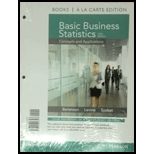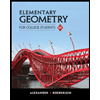
Basic Business Statistics, Student Value Edition (13th Edition)
13th Edition
ISBN: 9780321946393
Author: Mark L. Berenson, David M. Levine, Kathryn A. Szabat
Publisher: PEARSON
expand_more
expand_more
format_list_bulleted
Concept explainers
Question
Chapter 3, Problem 66PS
a.
To determine
Find and interpret the
b.
To determine
Find the
c.
To determine
Draw the boxplot and describe the shape.
d.
To determine
Draw the conclusion about the number of troughs that will meet the company’s requirements of troughs being between 8.31 and 8.61 inches wide.
Expert Solution & Answer
Want to see the full answer?
Check out a sample textbook solution
Students have asked these similar questions
Please help me with this question on statistics
Please help me with this statistics question
Please help me with the following statistics questionFor question (e), the options are:Assuming that the null hypothesis is (false/true), the probability of (other populations of 150/other samples of 150/equal to/more data/greater than) will result in (stronger evidence against the null hypothesis than the current data/stronger evidence in support of the null hypothesis than the current data/rejecting the null hypothesis/failing to reject the null hypothesis) is __.
Chapter 3 Solutions
Basic Business Statistics, Student Value Edition (13th Edition)
Ch. 3 - The following set of data is from sample of n=5:...Ch. 3 - The following set of data is from sample of n=6:...Ch. 3 - The following set of data is from sample of n=7:...Ch. 3 - The following set of data is from sample of n=5:...Ch. 3 - Suppose that the rate of return for a particular...Ch. 3 - Suppose that the rate of return for a particular...Ch. 3 - Prob. 7PSCh. 3 - The operation manager of a plant that manufactures...Ch. 3 - Prob. 9PSCh. 3 - The file FastFood contains the amount that a...
Ch. 3 - The file Sedans contains the overall miles per...Ch. 3 - The file SUV contains the overall miles per gallon...Ch. 3 - Prob. 13PSCh. 3 - Prob. 14PSCh. 3 - Is there a difference in the variation of the...Ch. 3 - Prob. 16PSCh. 3 - A bank branch located in a commercial district of...Ch. 3 - Suppose that another bank branch, location in a...Ch. 3 - Prob. 19PSCh. 3 - Prob. 20PSCh. 3 - Prob. 21PSCh. 3 - In 2009 through 2012, the value of precious metals...Ch. 3 - Prob. 23PSCh. 3 - Using the one-year return percentage variable in...Ch. 3 - Prob. 25PSCh. 3 - Prob. 26PSCh. 3 - The following is a set of data from a sample of...Ch. 3 - The following is a set of data from a sample of...Ch. 3 - The following is a set of data from a sample of...Ch. 3 - The following is a set of data from a sample of...Ch. 3 - Prob. 31PSCh. 3 - Prob. 32PSCh. 3 - The file HotelAway contains the average room price...Ch. 3 - Prob. 34PSCh. 3 - Prob. 35PSCh. 3 - A bark branch located in a commercial district of...Ch. 3 - The following is a set of data for a population...Ch. 3 - The following is a set of data for a population...Ch. 3 - Prob. 39PSCh. 3 - Consider a population of 1.024 mutual funds that...Ch. 3 - Prob. 41PSCh. 3 - Prob. 42PSCh. 3 - Thirty companies comprise the DJIA Just how big...Ch. 3 - The following is a set of data from sample of n=11...Ch. 3 - Prob. 45PSCh. 3 - Prob. 46PSCh. 3 - Movie companies need to predict the gross receipts...Ch. 3 - College football is big business, with coaches’...Ch. 3 - A Pew Research Center survey found a noticeable...Ch. 3 - What are the properties of a set of numerical...Ch. 3 - What is meant by the property of central tendency?Ch. 3 - What are the differences among the mean, median,...Ch. 3 - How do you interpret the first quartile, median,...Ch. 3 - What is meant by the property of variation?Ch. 3 - What does the Z score measure?Ch. 3 - What are the differences among the various...Ch. 3 - How does the empirical rule help explain the ways...Ch. 3 - How do the empirical rule and the Chebyshev rule...Ch. 3 - What is meant by the property of shape?Ch. 3 - What is the difference between the arithmetic mean...Ch. 3 - What is the difference between skewness and...Ch. 3 - How do the covariance and the coefficient of...Ch. 3 - The American Society for Quality (ASQ) conducted a...Ch. 3 - Prob. 64PSCh. 3 - One of the 111801 measures of the quality of...Ch. 3 - Prob. 66PSCh. 3 - Prob. 67PSCh. 3 - Prob. 68PSCh. 3 - A quality characteristic of interest for a...Ch. 3 - The manufacturer of Boston and Vermont asphalt...Ch. 3 - Prob. 71PSCh. 3 - The file Protein contains calories. protein. and...Ch. 3 - The file HotelPrices contains the prices in...Ch. 3 - Prob. 74PSCh. 3 - The file CEO-includes the total compensation...Ch. 3 - Prob. 76PSCh. 3 - Prob. 77PSCh. 3 - Prob. 78PSCh. 3 - You are planning to study for your statistics...Ch. 3 - The file DomesticBeer contains the percentage...
Knowledge Booster
Learn more about
Need a deep-dive on the concept behind this application? Look no further. Learn more about this topic, statistics and related others by exploring similar questions and additional content below.Similar questions
- Please help me with the following question on statisticsFor question (e), the drop down options are: (From this data/The census/From this population of data), one can infer that the mean/average octane rating is (less than/equal to/greater than) __. (use one decimal in your answer).arrow_forwardHelp me on the following question on statisticsarrow_forward3. [15] The joint PDF of RVS X and Y is given by fx.x(x,y) = { x) = { c(x + { c(x+y³), 0, 0≤x≤ 1,0≤ y ≤1 otherwise where c is a constant. (a) Find the value of c. (b) Find P(0 ≤ X ≤,arrow_forwardNeed help pleasearrow_forward7. [10] Suppose that Xi, i = 1,..., 5, are independent normal random variables, where X1, X2 and X3 have the same distribution N(1, 2) and X4 and X5 have the same distribution N(-1, 1). Let (a) Find V(X5 - X3). 1 = √(x1 + x2) — — (Xx3 + x4 + X5). (b) Find the distribution of Y. (c) Find Cov(X2 - X1, Y). -arrow_forward1. [10] Suppose that X ~N(-2, 4). Let Y = 3X-1. (a) Find the distribution of Y. Show your work. (b) Find P(-8< Y < 15) by using the CDF, (2), of the standard normal distribu- tion. (c) Find the 0.05th right-tail percentage point (i.e., the 0.95th quantile) of the distri- bution of Y.arrow_forward6. [10] Let X, Y and Z be random variables. Suppose that E(X) = E(Y) = 1, E(Z) = 2, V(X) = 1, V(Y) = V(Z) = 4, Cov(X,Y) = -1, Cov(X, Z) = 0.5, and Cov(Y, Z) = -2. 2 (a) Find V(XY+2Z). (b) Find Cov(-x+2Y+Z, -Y-2Z).arrow_forward1. [10] Suppose that X ~N(-2, 4). Let Y = 3X-1. (a) Find the distribution of Y. Show your work. (b) Find P(-8< Y < 15) by using the CDF, (2), of the standard normal distribu- tion. (c) Find the 0.05th right-tail percentage point (i.e., the 0.95th quantile) of the distri- bution of Y.arrow_forward== 4. [10] Let X be a RV. Suppose that E[X(X-1)] = 3 and E(X) = 2. (a) Find E[(4-2X)²]. (b) Find V(-3x+1).arrow_forward2. [15] Let X and Y be two discrete RVs whose joint PMF is given by the following table: y Px,y(x, y) -1 1 3 0 0.1 0.04 0.02 I 2 0.08 0.2 0.06 4 0.06 0.14 0.30 (a) Find P(X ≥ 2, Y < 1). (b) Find P(X ≤Y - 1). (c) Find the marginal PMFs of X and Y. (d) Are X and Y independent? Explain (e) Find E(XY) and Cov(X, Y).arrow_forward32. Consider a normally distributed population with mean μ = 80 and standard deviation σ = 14. a. Construct the centerline and the upper and lower control limits for the chart if samples of size 5 are used. b. Repeat the analysis with samples of size 10. 2080 101 c. Discuss the effect of the sample size on the control limits.arrow_forwardConsider the following hypothesis test. The following results are for two independent samples taken from the two populations. Sample 1 Sample 2 n 1 = 80 n 2 = 70 x 1 = 104 x 2 = 106 σ 1 = 8.4 σ 2 = 7.6 What is the value of the test statistic? If required enter negative values as negative numbers (to 2 decimals). What is the p-value (to 4 decimals)? Use z-table. With = .05, what is your hypothesis testing conclusion?arrow_forwardarrow_back_iosSEE MORE QUESTIONSarrow_forward_ios
Recommended textbooks for you
 Mathematics For Machine TechnologyAdvanced MathISBN:9781337798310Author:Peterson, John.Publisher:Cengage Learning,
Mathematics For Machine TechnologyAdvanced MathISBN:9781337798310Author:Peterson, John.Publisher:Cengage Learning, Elementary Geometry For College Students, 7eGeometryISBN:9781337614085Author:Alexander, Daniel C.; Koeberlein, Geralyn M.Publisher:Cengage,
Elementary Geometry For College Students, 7eGeometryISBN:9781337614085Author:Alexander, Daniel C.; Koeberlein, Geralyn M.Publisher:Cengage, Elementary Geometry for College StudentsGeometryISBN:9781285195698Author:Daniel C. Alexander, Geralyn M. KoeberleinPublisher:Cengage Learning
Elementary Geometry for College StudentsGeometryISBN:9781285195698Author:Daniel C. Alexander, Geralyn M. KoeberleinPublisher:Cengage Learning Trigonometry (MindTap Course List)TrigonometryISBN:9781337278461Author:Ron LarsonPublisher:Cengage Learning
Trigonometry (MindTap Course List)TrigonometryISBN:9781337278461Author:Ron LarsonPublisher:Cengage Learning Trigonometry (MindTap Course List)TrigonometryISBN:9781305652224Author:Charles P. McKeague, Mark D. TurnerPublisher:Cengage Learning
Trigonometry (MindTap Course List)TrigonometryISBN:9781305652224Author:Charles P. McKeague, Mark D. TurnerPublisher:Cengage Learning

Mathematics For Machine Technology
Advanced Math
ISBN:9781337798310
Author:Peterson, John.
Publisher:Cengage Learning,

Elementary Geometry For College Students, 7e
Geometry
ISBN:9781337614085
Author:Alexander, Daniel C.; Koeberlein, Geralyn M.
Publisher:Cengage,

Elementary Geometry for College Students
Geometry
ISBN:9781285195698
Author:Daniel C. Alexander, Geralyn M. Koeberlein
Publisher:Cengage Learning

Trigonometry (MindTap Course List)
Trigonometry
ISBN:9781337278461
Author:Ron Larson
Publisher:Cengage Learning

Trigonometry (MindTap Course List)
Trigonometry
ISBN:9781305652224
Author:Charles P. McKeague, Mark D. Turner
Publisher:Cengage Learning
Finding Local Maxima and Minima by Differentiation; Author: Professor Dave Explains;https://www.youtube.com/watch?v=pvLj1s7SOtk;License: Standard YouTube License, CC-BY